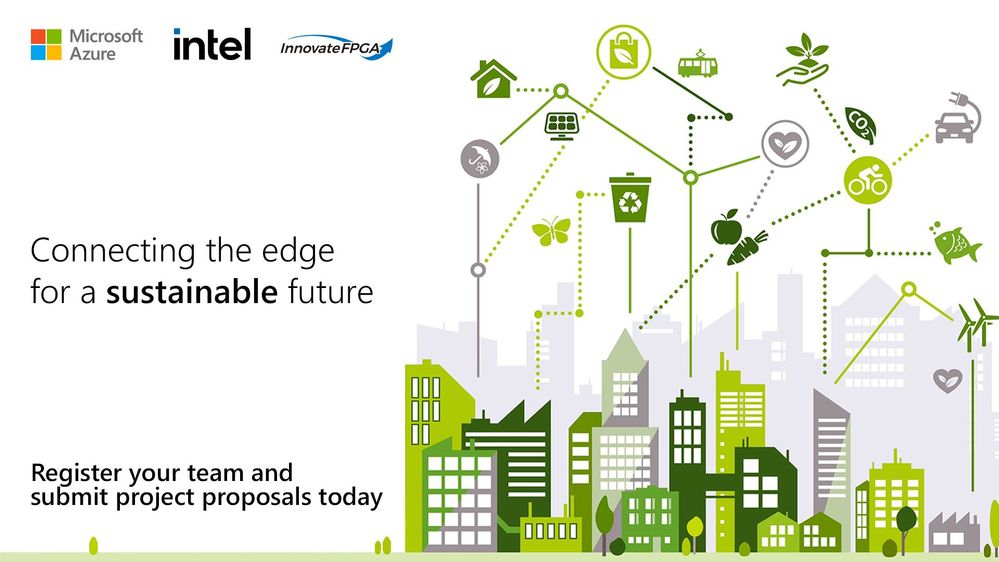This article is contributed. See the original author and article here.
Microsoft and Intel empower technologies that can build a more environmentally sustainable future and reduce the demand we place on Earth’s resources. That’s why Microsoft Azure IoT and Intel are partnering with the InnovateFPGA Design Contest, where developers can harness Azure cloud computing and Intel® FPGA technology to create solutions that reduce environmental impacts.
The design contest is looking for inventive developers from around the globe who can create cutting-edge solutions. Internet of Things (IoT) solutions are already reducing climate impact: from smart lighting that turns off when not needed to transportation systems that reduce pollution-exacerbating car congestion. New IoT solutions could address unique challenges, such as reducing the waste of resources such as water, tracking ocean life, or increasing protection of endangered species.
FPGA Cloud Connectivity Kits, provided to qualified teams in the InnovateFPGA contest, show how an Intel® Edge-Centric FPGA (field programmable gate array) can connect seamlessly with Azure IoT. In addition, development teams will have a choice to use Azure IoT Central or IoT Hub to connect their solution to the Azure cloud. Developers interested in building sustainable solutions using this technology can register their team at www.innovatefpga.com.
Working jointly to encourage innovative developers
Azure IoT and Intel already work jointly together in advanced solutions, complementing each other’s technology to address challenges in a variety of industries. The FPGA Cloud Connectivity Kit enables innovative developers to perform new tasks and solve more challenges, as real-time handling of Azure workloads is easier with a dedicated FPGA-based hardware accelerator. FPGA circuits also can be configured specifically for various workloads to provide better performance and flexibility.
Additionally, Azure IoT Central, IoT Hub, and IoT Plug and Play help builders and developers connect devices to the cloud. IoT Central offers a secure platform, centralized management to reconfigure and update devices, and a growing selection of IoT app templates for common scenarios. IoT Hub, meanwhile, enables secure and reliable communication via the cloud between IoT applications and the devices they manage. Finally, IoT Plug and Play seeks to remove technical barriers, reducing development time, cost, and complexity.

How Microsoft Azure and Intel can reduce environmental impacts
Sustainability and environmental efforts by Microsoft and Intel go beyond their support of the InnovateFPGA contest. As part of our commitment to put sustainable technologies at the heart of our innovation, we’re focused on four key areas of environmental impact to local communities: carbon, water, waste, and ecosystems. We’re striving to use 100% renewable energy by 2025, replenish more water than we consume by 2030, create zero waste annually by that same year, and achieve net-zero deforestation from new construction. Enterprises looking to understand and potentially reduce their environmental impacts can use the Sustainability Calculator.
Just as Azure cloud computing can help reduce energy use, Intel FPGA-enabled architecture used with the cloud is economical and power-efficient, making high-performance computing more sustainable. Microsoft is also researching new approaches for improving computing and cloud data handling while simultaneously using less energy and more sustainable materials.
Project 15 from Microsoft also is helping to accelerate conservation organizations and scientific teams reduce costs and complexity in deploying IoT technologies through its open-source software platform. The Global Environment Facility (GEF) Small Grants Programme, implemented by the United Nations Development Program, is collaborating with the InnovateFPGA contest to task teams to create solutions for biodiversity, sustainable agriculture, and marine conservation. The GEF has shared use cases from the Project 15 initiative on the contest website.
Submit design proposals to the InnovateFPGA Design Contest
Regional teams of university students, builders, and professional engineers with the creativity and ingenuity to design solutions for challenging environmental issues are encouraged to participate in the InnovateFPGA Design Contest. Teams must register and submit their solution proposals at the contest registration page by Sept. 30, 2021. After registering, free FPGA Cloud Connectivity Kits will be shipped to teams whose proposals are selected to advance forward.
Qualifying teams will develop solutions for sustainability until Spring 2022, where they will compete in their respective regional competition. Teams at this level will have a chance to win cash prizes and an invitation to the Grand Finale event at Intel headquarters in San Jose, California, in 2022. For more details, rules, and an FAQ page, go to www.innovatefpga.com.
Brought to you by Dr. Ware, Microsoft Office 365 Silver Partner, Charleston SC.


Recent Comments